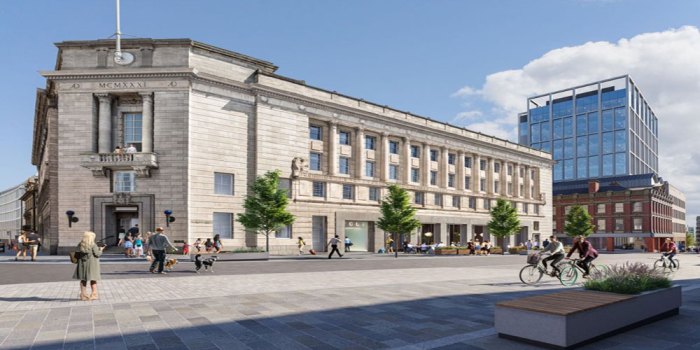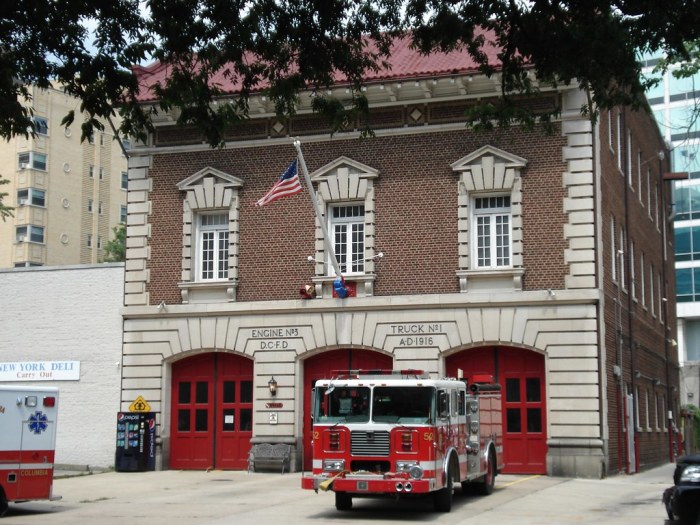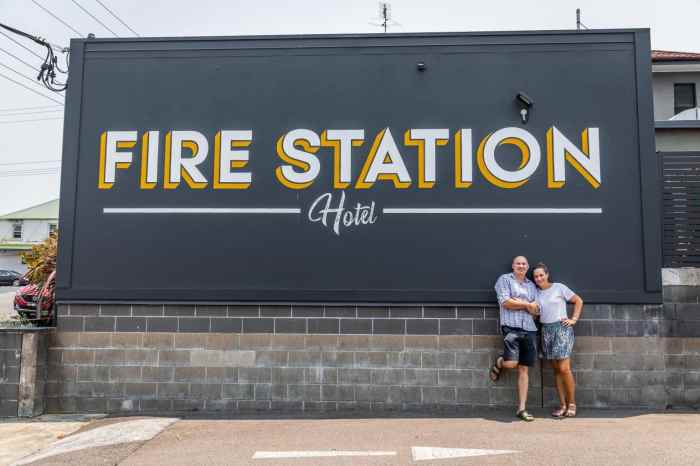Fire station hotels, once symbols of community safety, are now reimagined as unique hospitality destinations. These adaptive reuse projects seamlessly blend historical charm with modern amenities, offering guests an immersive experience that celebrates the legacy of firefighting while providing exceptional comfort.
The conversion of fire stations into hotels presents architectural challenges and opportunities. Architects must carefully preserve the original architectural features that evoke the building’s history while incorporating modern amenities that meet the needs of contemporary travelers.
Hotel Amenities and Services

Fire station hotels offer a unique blend of modern amenities and historic charm, catering to the diverse needs of guests. These amenities have evolved over time, reflecting the changing role of fire stations and the increasing demand for comfortable and convenient accommodations.
One of the most distinctive amenities is the presence of original firehouse features, such as brass fire poles, antique fire engines, and historic photographs. These elements provide a glimpse into the past and create a nostalgic atmosphere. Guests can enjoy a stay in a genuine firehouse, experiencing the ambiance and history firsthand.
Dining Options
Many fire station hotels feature on-site restaurants or bars, offering a range of dining options. These restaurants often serve locally sourced cuisine and craft beverages, showcasing the culinary scene of the surrounding area. Guests can enjoy meals in a historic setting, surrounded by firehouse memorabilia.
Fitness Facilities
To cater to the fitness needs of guests, some fire station hotels provide fitness centers or gymnasiums. These facilities may include state-of-the-art equipment and offer fitness classes, allowing guests to maintain their workout routines while traveling.
Meeting and Event Spaces
Fire station hotels often have meeting rooms or event spaces available for rent. These spaces are ideal for corporate events, conferences, or special occasions. The unique ambiance and historic character of the firehouse setting can add a memorable touch to any gathering.
Pet-Friendly Policies
Recognizing the importance of pets to many travelers, some fire station hotels welcome furry companions. Pet-friendly policies allow guests to bring their dogs or cats along, making their stay more comfortable and convenient.
Adaptive Reuse and Design

Adaptive reuse of fire stations into hotels presents unique architectural challenges and opportunities. Preserving the original architectural features of fire stations enhances the hotel experience by providing a distinctive and historically rich atmosphere.
Case Studies of Successful Adaptive Reuse Projects
Several successful adaptive reuse projects have demonstrated the potential of converting fire stations into hotels. One notable example is the Firehouse Hotel in Chicago, which has preserved the original facade and interiors of the historic fire station, including the fire poles and hose tower.
Another example is the Hotel de la Vieille Caserne in Paris, which has transformed a former fire station into a luxury hotel. The hotel features original architectural elements such as vaulted ceilings, arched windows, and a courtyard.
Design Strategies and Preservation Efforts
Adaptive reuse projects require careful design strategies to balance the preservation of historic features with the needs of a modern hotel. Common strategies include:
- Retaining original architectural elements, such as facades, windows, and doors
- Preserving interior details, such as fire poles, hose towers, and brass fittings
- Incorporating modern amenities and technology into the historic structure
- Creating new spaces that complement the original architecture
Preservation efforts are essential to maintain the historic character of the fire station. This may involve restoring damaged elements, repairing original materials, and adhering to historic preservation guidelines.
Enhancement of Hotel Experience, Fire station hotel
The original architectural features of fire stations contribute to a unique and memorable hotel experience. Guests can appreciate the historic significance of the building, while enjoying modern amenities and services.
The large, open spaces of fire stations provide ample room for hotel facilities such as restaurants, bars, and meeting spaces. The high ceilings and large windows create a sense of grandeur and spaciousness.
Additionally, the preserved fire station equipment and memorabilia serve as a reminder of the building’s past, adding to the overall ambiance of the hotel.
Historical Context and Significance: Fire Station Hotel

Fire stations have a long and rich history, dating back to the early days of organized firefighting. These buildings have played a vital role in protecting communities from fires and other emergencies, and many have been converted into hotels in recent years.
Fire station hotels, once prevalent, have largely faded into history. However, their legacy lives on in establishments like Hotel dan Motel Glendambo , which retains its original fire station facade. This unique property offers a glimpse into the past while providing modern amenities for travelers seeking a memorable and historical experience.
Despite the decline of fire station hotels, their architectural charm and historical significance continue to fascinate and inspire.
The conversion of fire stations into hotels preserves their cultural heritage while giving them a new lease on life. These buildings often have unique architectural features and historical significance, and they can provide guests with a unique and memorable experience.
Stories and Anecdotes
- The Old Fire Station Hotel in Alexandria, Virginia, was originally built in 1885. It served as the city’s fire station for over 100 years before being converted into a hotel in 2005. The hotel still retains many of its original features, including the firehouse bell and the firemen’s pole.
- The Firehouse Hotel in New York City was built in 1904 and was once one of the busiest fire stations in the city. It was converted into a hotel in 2011 and now offers guests a unique opportunity to stay in a piece of New York City history.
Location and Neighborhood

Fire station hotels are typically located in urban areas, often in historic districts or near cultural attractions. This strategic placement allows guests to easily explore the surrounding neighborhood and take advantage of local amenities.The proximity to historical landmarks, museums, and theaters enriches the guest experience, providing opportunities for cultural immersion and historical exploration.
Guests can step outside their hotel and immerse themselves in the local history and culture, fostering a deeper connection with the destination.Moreover, the presence of local businesses, such as restaurants, cafes, and shops, enhances the neighborhood’s vitality and provides guests with convenient access to a range of services and dining options.
This integration with the local community creates a vibrant and authentic atmosphere, allowing guests to experience the neighborhood’s unique character.
Revitalization of Neighborhoods
Fire station hotels have played a significant role in revitalizing neighborhoods. Their adaptive reuse breathes new life into historic buildings, preserving their architectural heritage while introducing a contemporary use that aligns with modern travelers’ needs.The influx of guests and increased foot traffic generated by fire station hotels stimulates local businesses, fostering economic growth and job creation.
Fire station hotels have a unique charm, combining historical significance with modern amenities. Dumbleyung Hotel, located in the heart of Western Australia, is a prime example of this blend. Dumbleyung Hotel: A Haven in the Heart of Western Australia offers a glimpse into the town’s rich past, while providing guests with a comfortable and convenient stay.
Fire station hotels continue to offer a unique and nostalgic experience, preserving a piece of history while catering to the needs of modern travelers.
This economic revitalization, coupled with the preservation of historic landmarks, contributes to the overall enhancement of the neighborhood’s character and livability.Notable examples of fire station hotels that have revitalized their neighborhoods include:
- The Siren Hotel in Detroit, Michigan, has helped to revitalize the city’s historic Corktown neighborhood.
- The Old Firehouse Hotel in Seattle, Washington, has contributed to the resurgence of the city’s Pioneer Square neighborhood.
- The Firehouse Hotel in Chicago, Illinois, has played a key role in the revitalization of the city’s River North neighborhood.
These hotels have become anchors for their respective neighborhoods, attracting visitors and stimulating economic development while preserving the area’s unique architectural heritage.
Unique Guest Experiences

Fire station hotels offer guests a unique opportunity to experience the history and culture of firefighting firsthand. From exploring historic fire trucks to participating in hands-on firefighting simulations, these hotels provide a truly immersive experience that is both educational and entertaining.
Many fire station hotels also offer guided tours of their facilities, led by experienced firefighters. These tours provide guests with an insider’s look at the daily operations of a fire station, including the equipment and techniques used by firefighters.
Firefighting Simulations
For guests who want to experience the thrill of firefighting firsthand, many fire station hotels offer hands-on firefighting simulations. These simulations allow guests to use real firefighting equipment, such as hoses and axes, to extinguish a simulated fire. These simulations are a great way to learn about the challenges and dangers of firefighting, while also having a lot of fun.
Many of these buildings were converted into residential dwellings. Some were even transformed into hotels. This practice is still being done today with the Fire Station Hotel in Jamison. However, a more detailed look at this concept can be found in Courthouse Hotel Jamieson: An In-Depth Analysis . This insightful article provides a comprehensive overview of the transformation of a courthouse into a hotel.
While the focus is on the Courthouse Hotel in Jamieson, it also sheds light on the broader trend of repurposing historic buildings into hospitality venues. The article explores the challenges and opportunities involved in such projects, offering valuable insights for anyone interested in the adaptive reuse of heritage buildings.
Testimonials
“I had an amazing time at the Fire Station Hotel. The staff was so friendly and knowledgeable, and the firefighting simulation was an incredible experience. I learned so much about the history and culture of firefighting, and I can’t wait to come back.”
– John Smith, TripAdvisor
“The Fire Station Hotel was the perfect place to stay for our family vacation. The kids loved exploring the fire trucks and participating in the firefighting simulations. We all learned a lot about the importance of fire safety, and we had a blast.”
– Mary Jones, Google Reviews
Closing Notes

Fire station hotels not only offer unique accommodations but also contribute to the revitalization of neighborhoods. Their proximity to historical landmarks, cultural attractions, and local businesses enhances the guest experience and fosters a sense of community. By embracing the past and adapting to the present, fire station hotels create a compelling blend of heritage and hospitality.
Question Bank
What amenities can guests expect at fire station hotels?
Fire station hotels often feature amenities such as fitness centers, rooftop terraces, and restaurants that pay homage to the building’s history.
How do fire station hotels preserve their historical significance?
Architects and designers work to retain original architectural elements such as fire poles, hose towers, and alarm systems, integrating them into the hotel’s design.
What types of neighborhoods are fire station hotels typically located in?
Fire station hotels are often found in historic districts, near cultural attractions, and in areas undergoing urban renewal.

